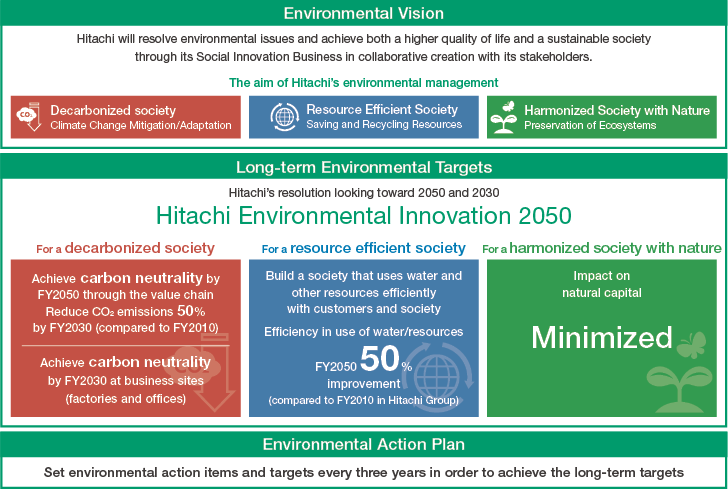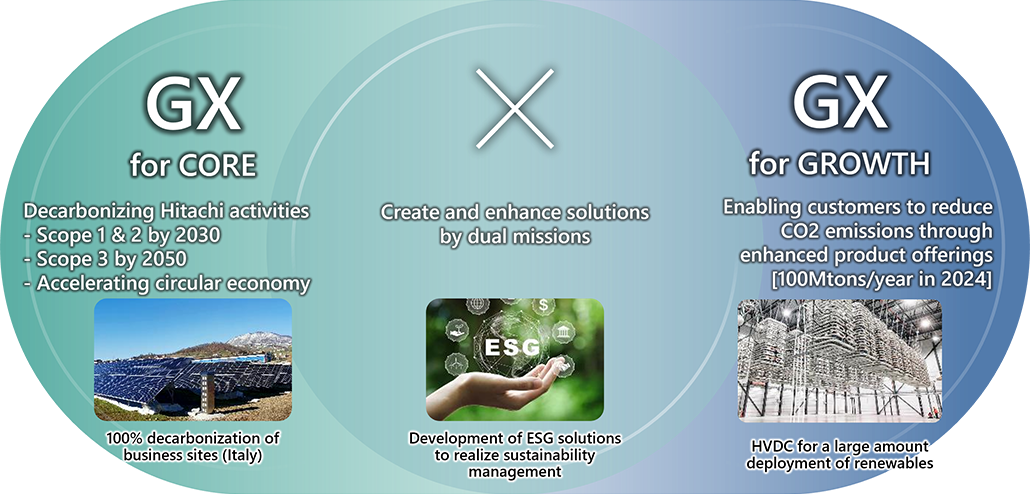Advancing Our Environmental Vision and Long-term Environmental Targets
- “Environmental Vision” and “Hitachi Environmental Innovation 2050”
- Progress in Reaching Hitachi Environmental Innovation 2050 Targets
- Green Strategy
- Environmental Action Plan
- Environmental Action Plan for 2024 (Fiscal 2022–2024)
The Environmental Vision and Long-Term Environmental Targets described here are the information as of the date of publication of Sustainability Report 2024.
Click here for Environmental Vision and Long-term Environmental Targets revised in May 2025.
“Environmental Vision” and “Hitachi Environmental Innovation 2050”
Approach & Policy
Strategy & Target
Taking into account the growing urgency of environmental issues in the world and the management policies, Hitachi formulated an Environmental Vision that clearly outlines our vision for society from a long-term perspective. In working toward achieving this vision, we have established a set of long-term environmental targets aimed at building a decarbonized society, a resource-efficient society, and a harmonized society with nature under the banner of Hitachi Environmental Innovation 2050 and are working to advance them.
With the aim of achieving a decarbonized society and based on the Paris Agreement and the discussions within the international community that followed its signing, Hitachi has set targets aimed at limiting the average global temperature rise to 1.5°C as compared to pre-industrial levels. Hitachi set the goal of achieving carbon neutrality by fiscal 2030 in our factories and offices, and by fiscal 2050 throughout our value chain. We are currently engaged in measures to achieve these goals.
To meet our goal of Achieving a Resource-Efficient Society, we aim to create a sustainable society, while keeping the transition to a circular economy in mind, by improving the efficiency of water and resources use at Hitachi by 50% by fiscal 2050 (compared to fiscal 2010 levels).
To meet our goal of Achieving a Harmonized Society with Nature, we strive to minimize our impact on natural capital by keeping a close eye on international initiatives such as the 15th Conference of the Parties (COP15) to the Convention on Biological Diversity, held in December 2022, and the Task Force on Nature-Related Financial Disclosure (TNFD).
Hitachi’s environmental initiatives, including the achievement of these long-term environmental targets, are mandated by the short-term Environmental Action Plan which is updated every three years and pursued Groupwide.
Environmental Vision and Long-term Environmental Targets: Hitachi Environmental Innovation 2050

Progress in Reaching Hitachi Environmental Innovation 2050 Targets
Activities
We are making progress with major Hitachi Environmental Innovation 2050 targets, as shown below. We are generally on track, and we will continue strengthening our environmental activities to achieve these targets. Regarding our long-term value chain target to help build a decarbonized society, we are developing activities which help to reduce CO2 emissions by providing products with top-tier environmental performance.
For a Decarbonized Society
Reduced CO2 Emissions at Business Sites (Factories and Offices)
| FY2023 Target | FY2023 Result | FY2030 Target | FY2050 Target | |
|---|---|---|---|---|
| Reduction Rate of Total CO2 (Compared to FY2010 Hitachi Group) | 35% | 74% | Carbon Neutrality | Carbon Neutrality |
For a Resource Efficient Society
Enhanced Efficiency in the Use of Waste and Valuable Generation at Business Sites (Factories and Offices)
| FY2023 Target | FY2023 Result | FY2030 Target | FY2050 Target | |
|---|---|---|---|---|
| Reduction Rate in Waste and Valuables Generation per Unit (Compared to FY2010 Hitachi Group) | 17% | 15% | ― | 50% reduction |
Enhanced Efficiency in the Use of Water at Business Sites (Factories and Offices)
| FY2023 Target | FY2023 Result | FY2030 Target | FY2050 Target | |
|---|---|---|---|---|
| Reduction Rate in Water Use per Unit (Compared to FY2010 Hitachi Group) | 23% | 30% | ― | 50% reduction |
Green Strategy
Approach & Policy
Green Strategies for Sustainable Growth
Through its Social Innovation Business, Hitachi is leading the way in resolving global environmental issues, helping to create a sustainable society that balances protecting the global environment with quality of life (QoL).
To realize this vision, Hitachi is promoting a green strategy consisting of two pillars. The first pillar, known as GX for CORE, accelerates the Hitachi Group’s own green transformation.
The second pillar, GX for GROWTH, provides innovative solutions, strongly supporting green transformation for customers and society.
By working on both pillars, GX for CORE and GX for GROWTH, Hitachi will accelerate the deeper development of technology and expertise, thus improving the environmental value it provides on a continued basis. Through the steady implementation of our green strategy, we will accelerate the realization of a decarbonized society, a resource-efficient society, and a society in harmony with nature, paving the way for a sustainable future where people can live with peace of mind.
The Hitachi Green Strategy

Environmental Action Plan
Approach & Policy
To achieve its Environmental Vision and the Hitachi Environmental Innovation 2050 long-term environmental targets, Hitachi draws up an Environmental Action Plan containing indicators and targets for the three-year period covered by the Mid-term Management Plan and steadily promotes its implementation.
Environmental Action Plan for 2024 (Fiscal 2022–2024)
Hitachi pursues environmental activities under the Environmental Action Plan for 2024 (Fiscal 2022–2024) that were based on the 2024 Mid-term Management Plan. The targets set for fiscal 2023 and our results are as follows.
Environmental Action Plan for 2024
Our environmental activities and targets are updated every three years with a view to achieving our long-term environmental targets.
Environmental Management
| Items | Indicators | FY2023 Targets | FY2023 Results (Achievement Level) |
Final FY (2024) Targets |
|
|---|---|---|---|---|---|
| Environmental human capital development |
Promote environmental human capital development |
Promote environmental human capital development | Environmental human capital development mindful of changes in personnel composition, including generational shifts | ||
A Decarbonized Society
◆◆◆: Achieved, ◆◆: Partially achieved
| Items | Indicators | FY2023 Targets | FY2023 Results (Achievement Level) |
Final FY (2024) Targets |
|
|---|---|---|---|---|---|
| Factories and offices | Reduce total CO2 | Reduction rate of total CO2*1 (compared to FY2010) | 35% | 74% ◆◆◆ |
50% |
| Improve transportation energy consumption per unit (Japan) |
Improvement rate of transportation energy consumption per unit (Japan)*2 (compared to FY2020) |
3% | 30% ◆◆◆ |
4% | |
| Products and services | Reduce CO2 emissions of products and services | Reduction rate of CO2 emissions per unit (compared to FY2010) | 13% | 24% ◆◆◆ |
14% |
| CO2 avoided emissions |
Target: CO2 avoided emissions of 100 million metric tons per year (FY2024) Forecast: CO2 avoided emissions of 153 million metric tons per year*3 |
||||
| Promote eco-design | Environmentally conscious design assessments and LCA application rates for newly developed and designed products |
Target: Full application Eco-Design for all newly developed products FY2023 Results: 198 products identified as subject of Eco-Design |
|||
A Resource Efficient Society
◆◆◆: Achieved, ◆◆: Partially achieved
| Items | Indicators | FY2023 Targets | FY2023 Results (Achievement Level) |
Final FY (2024) Targets |
|
|---|---|---|---|---|---|
| Products and services | Promote eco-design | Environmentally conscious design assessments and LCA application rates for newly developed and designed products |
Target: Full application Eco-Design for all newly developed products FY2023 Results: 198 products identified as subject of Eco-Design |
||
| Factories and offices | Enhance efficiency in the use of resources | Number of sites achieving zero landfill waste*4 | 124 | 146 ◆◆◆ |
158 |
| Reduction rate in waste and valuables generation per unit (compared to FY2010) |
17% | 15% ◆◆ |
20% | ||
| Reduction rate in water use per unit (compared to FY2010) | 23% | 30% ◆◆◆ |
24% | ||
| Effective utilization rate of plastic waste | 81% | 96% ◆◆◆ |
85% | ||
| Water risks | Respond to water risks | Responding to water risks | Minimization of business impacts regarding water risks | ||
A Harmonized Society with Nature
◆◆◆: Achieved, ◆◆: Partially achieved
| Items | Indicators | FY2023 Targets | FY2023 Results (Achievement Level) |
Final FY (2024) Targets |
||
|---|---|---|---|---|---|---|
| Water risks | Respond to water risks | Responding to water risks | Minimization of business impacts regarding water risks | |||
| Chemical substance | Reduce chemical emissions | Reduction rate in chemical atmospheric emissions per unit (compared to FY2010) |
6% | 22% ◆◆◆ |
8% | |
| Ecosystem preservation | Impact on natural capital | Calculation of negative impacts (business unit/group company-level LCA implementation) / Calculation of positive impacts (forest conservation activities) | ||||
*1Reduction rate of total CO2: Indicator representing CO2 emissions from Hitachi’s consumption of energy alone
*2This is a target for Japan only. Targets in other countries are set on a voluntary basis
*3Three-year average
*4Pursued in assumed conformance with regulations, conditions, etc. Less than 0.5%